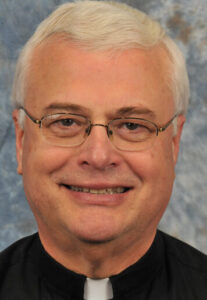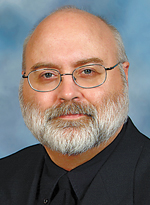
Priests of the Diocese of Davenport and visiting priests pray during the ordination Mass June 1 at Sacred Heart Cathedral in Davenport.
By Barb Arland-Fye
The Catholic Messenger

You could hear an audible gasp in the congregation at Sacred Heart Cathedral in Davenport. It happened at the end of the Liturgy of Ordination of Fathers Dane Dickinson and Mike Snyder last month. Vocations Director Father Jake Greiner told the congregation that no one would be ordained to the priesthood in the Davenport Diocese next year and asked the congregation to pray for and encourage vocations to the priesthood. The announcement underscored the need for proactive parish planning.
Just 25 of the current 44 Davenport diocesan priests assigned to the 74 parishes in the Diocese of Davenport will be below the retirement age of 70 by the end of 2030, diocesan projections show. When factoring in 5 projected ordinations, and counting on 7 priests from outside the diocese continuing to serve here, the total number of priests serving our diocese would reduce from 51 to 37 by 2030, or about two fewer priests per year, says Dan Ebener, diocesan director of Parish Planning.
Paralleling that statistic is the declining number of parishioners in those parishes. Mass counts, sacramental records such as baptisms, weddings and funerals, and other quantitative measures of parish activity are showing similar declines, which must also factor into the parish planning process.
While that trend echoes many dioceses’ experience nationwide, the Davenport Diocese is taking a unique approach that involves the participation of parishioners and parish priests in addressing the challenges. “It’s being called the ‘Davenport model’ — making adjustments one year at a time as the shortage of priests is being realized,” Ebener said. “The phrase I use is ‘just in time,’ where, for example, if the number of priests goes down by two in a given year, we figure out how to serve the diocese with two fewer priests. Other dioceses nationwide have been taking an ‘all at once’ approach.”
The “just in time” approach allows members of the diocesan parish planning team to “work with the one, two or three parishes that will be affected on preparing for the transition. When you do an ‘all at once’ approach, there’s no way to provide that level of support to that many parishes,” Ebener said. The parish planning team (diocesan administrator, vicar general, diocesan chief of staff, and Ebener) will share this approach for consideration by Bishop-Elect Dennis Walsh, whose installation and ordination take place Sept 27. His immediate predecessors developed and built on the approach.
 Priest retirements, ordinations and the number of parishioners engaged actively in their parishes figure into the planning process. Priest health is another factor. Younger priests, in particular, “are concerned about the number of parishes we have, and the possibility of burning out the priests,” Ebener said. “Most priests also express a concern about being overwhelmed with administrative duties and not having enough time and energy for their pastoral, spiritual and sacramental responsibilities.”
Priest retirements, ordinations and the number of parishioners engaged actively in their parishes figure into the planning process. Priest health is another factor. Younger priests, in particular, “are concerned about the number of parishes we have, and the possibility of burning out the priests,” Ebener said. “Most priests also express a concern about being overwhelmed with administrative duties and not having enough time and energy for their pastoral, spiritual and sacramental responsibilities.”
“Two or three years in advance, we try to project how many changes we need to make per year, and what areas of the diocese could be served with one fewer priest. That usually means clustering one, two or three new sets of parishes per year,” Ebener said. “We also discuss how we can involve the priests, deacons and parishioners in these decisions and how to prepare parishes for the changes. This usually includes a face-to-face visit to the area by the bishop and the director of parish planning several months ahead to listen to the people’s concerns and to prepare the people for necessary changes.”
Plans change!
Diocesan parish planners envision mission-oriented “pastoral teams,” that might consist of one pastor, one to two parochial vicars, a deacon, a business manager, a director of evangelization and other staff assigned to a region, for example.
“I think we have done a good job of doing periodic strategic planning, coupled with a ‘year by year’ approach based on needs as they arise. We have been able to be agile,” said Father Thom Hennen, pastor of Sacred Heart Cathedral, and member of the diocesan parish planning team.
“We have seen other dioceses in the country that have reached ‘crisis points’ in which they needed to do massive restructuring (closures, consolidations, etc.) all at once. I think we have done a good job of avoiding that by planning along the way. There are advantages and disadvantages to both approaches but I think there is greater opportunity for the people to feel a part of the decision-making process when this kind of discernment happens year by year,” Father Hennen said.
“Some have complained that in the past we have come up with plans and then not followed them to a tee. However, situations change, demographics change, personnel change, priests change, and not every peg fits in every hole,” Father Hennen said. “A plan may look good on paper and make sense, from 30,000 feet but not be workable on the ground.”
On June 30, the Missionaries of the Precious Blood concluded 86 years of serving in the Davenport Diocese with the departure of Fathers Timothy Armbruster and Father Mark Yates (see story on Page 3). “They were gracious enough to give us ample time to put plans in place,” Father Hennen said. That led to other considerations. “For example, we knew that we would probably not always be able to maintain a resident priest in Colfax (which until recent years had been without one) so that was one place where we knew we could draw from if needed.”

Father Dominic Nguyen, parochial vicar at Divine Mercy Parish in Burlington/West Burlington, speaks to Totus Tuus youths at St. Alphonsus Parish in Mount Pleasant last month.
Working together
“I have been impressed by the willingness of the priests to do what we ask them to do,” said Diocesan Administrator Father Ken Kuntz, who is leading the diocese until Bishop-Elect Walsh becomes the diocese’s bishop. Father Kuntz himself stepped out of retirement to accept the diocesan administrator appointment after now-Archbishop Thomas Zinkula left last October to lead the Dubuque Archdiocese.

“Next year, we don’t have any ordinations to the priesthood. That presents a challenge,” Father Kuntz said. “Different priests have different challenges, different abilities. Sometimes they are willing to move and sometimes they are not. Most of the times they say yes. We rely on the Holy Spirit to give us ideas on who to ask and how that will work out.”
Father Kuntz also sees the need for parishes to take on more administrative responsibilities with trained lay people. “For priests, it’s about preaching, presiding and providing pastoral care — that’s what we’re ordained to do,” he said. “In more recent years, I feel parishes understand the challenges and are willing to dialogue and explore how we can work together.” He said there was a time when talk of a priest shortage created panic in parishes. “They were fearful their parishes would be closed. Now they see the diocese is making every conceivable effort to keep their parishes open.”

Diocesan Chief of Staff Deacon David Montgomery said the current planning process “has served the diocese well in a shifting environment of populations, staffing availability, economics, and evangelization pursuits.” Unanticipated changes can have a domino effect. “Previous planning is considered while taking into consideration changes since the plans were made. Then forecasts of future needs and resources are attempted.”
When Archbishop Zinkula led the Davenport Diocese, he “organized meetings with the group of pastors affected by the changes in assignments. Best practices were shared among the group and resources were identified that could benefit individual situations,” Deacon Montgomery said. “Dan Ebener also worked with the group and the individual parishes that were affected.”
Thriving parishes
Articles like this one, the first in a series about parish planning, will help parishes prepare for changes that will affect them, Father Hennen said. “I think that even if many people know there are fewer priests and that demographics have changed dramatically (especially in rural areas), they don’t act any differently. Expectations of priests remain relatively unchanged. Even a 15-minute change in Mass times, so that the priest can accommodate Mass in another community, may cause some to consider leaving the parish.” Yes, people have a right to the sacraments and we want to do everything we possibly can for their enrichment in the faith but they also need to open their eyes to some of these difficult realities.”
Father Hennen believes the diocese could benefit from “adopting more of a missionary model. We need to look at examples from the global Church and not always be comparing ourselves to the ‘Catholic heyday’ of post-war America. There are places in the world where the Church is not only surviving but also in some cases even thriving with few priests. We have parishes in our own diocese that hold their own very well. They have robust ministries and are attracting families. They love their priests and deacons but understand that they have other obligations and communities to serve. There’s no reason, to my mind, to consider consolidating some of these smaller parishes. You can be a small, but still vibrant, eucharistically centered community.”








